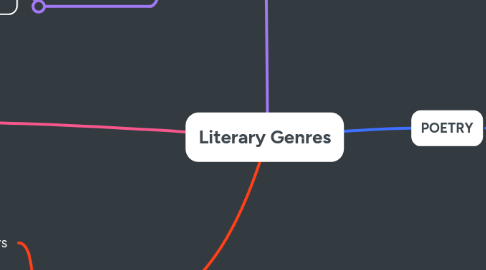
1. POETRY
1.1. Theme
1.1.1. main idea in the poem
1.2. Speaker
1.2.1. who is speaking in the poem
1.3. Dramatic Situation
1.3.1. illuminating a conflict or tension
1.4. Diction
1.4.1. Abstract
1.4.2. Concrete
1.4.3. General
1.4.4. Specific
1.4.5. Formal
1.4.6. Informal
1.4.7. Denotative
1.4.8. Connotative
1.5. Figures of Speech
1.5.1. Simile
1.5.2. Metaphor
1.5.3. Metonymy
1.5.4. Paranomasia
1.5.5. Personification
1.5.6. Apostrophe
1.5.7. Hyperbole
1.5.8. Oxymoron
1.5.9. Paradox
1.6. Imagery
1.6.1. images that mean something
1.7. Tone
1.7.1. **“mood”**
1.8. Irony
1.8.1. Ironic Point of View
1.8.2. Verbal Irony
1.8.3. Dramatic Irony
1.8.4. Situational Irony
1.9. Sound
1.9.1. Euphony
1.9.2. Cacophony
1.9.3. Onomatopoeia
1.9.4. Alliteration
1.9.5. Rhyme
1.10. Rhythm
1.10.1. Fixed Forms
1.10.2. Open forms
2. DRAMA
2.1. Characters
2.1.1. actors
2.2. Stage Direction
2.2.1. blockings
2.3. Plot
2.3.1. series of events
2.4. Dialogue
2.4.1. conversations
3. FICTION
3.1. Characters
3.1.1. person, animal, being, creature, or thing in a story
3.2. Setting
3.2.1. place where the story is
3.3. Conflict
3.3.1. problems
3.4. Plot
3.4.1. Classic Plot
3.4.2. Episodic Plot
3.5. Narrator
3.5.1. Intrusive
3.5.1.1. addresses the reader directly
3.5.2. Unreliable
3.5.2.1. untrustworthy storyteller
3.6. Symbol
3.6.1. something that has literal meaning in a story
3.7. Theme
3.7.1. a central, unifying idea
3.8. Point of view
3.8.1. dictates how readers interpret the events and important details
4. CREATIVE NON-FICTION
4.1. Memoir
4.1.1. single event
4.2. Biography
4.2.1. written by another person
4.3. Autobiography
4.3.1. written by the author himself
4.4. Diary
4.4.1. collection of discrete accounts
4.5. Essay
4.5.1. communicating ideas and arguments in the clearest way possible
